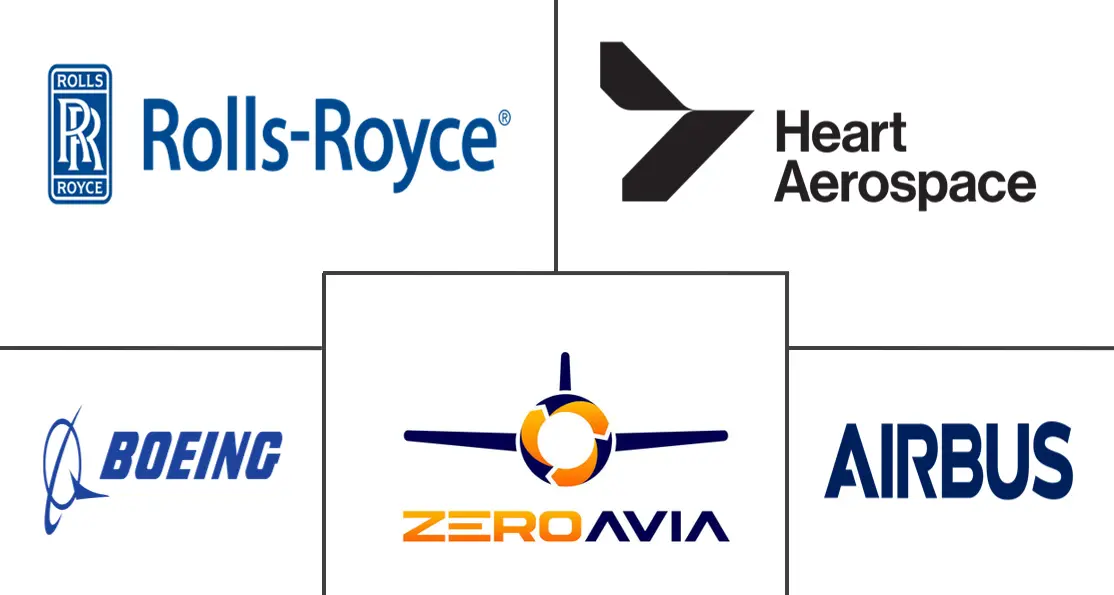Zero-emission Aircraft Market Size and Share
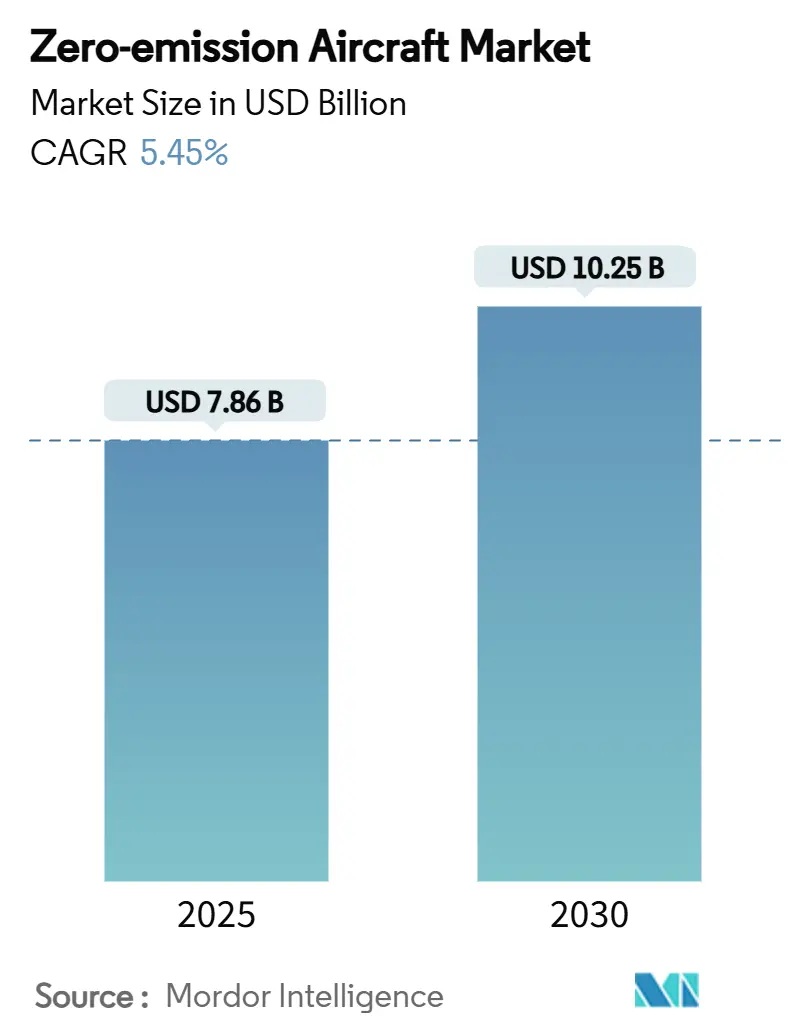
Zero-emission Aircraft Market Analysis by Mordor Intelligence
The zero-emission aircraft market size is estimated at USD 7.86 billion in 2025 and is projected to reach USD 10.25 billion in 2030, registering a 5.45% CAGR over the forecast period. Robust policy support, record venture funding, and breakthroughs in hydrogen fuel cells and high-energy-density batteries accelerate technology readiness across commercial, general, and military platforms. Commercial operators remain the largest adopters on the strength of fleet replacement cycles, while general aviation is advancing fastest because of simpler certification pathways. Hybrid electric propulsion dominates, but hydrogen systems are gaining momentum as cryogenic storage hurdles ease. Battery advances are pushing viable range limits beyond the short-haul niche, and unmanned aerial systems (UAS) are proving out architectures more quickly than crewed programs thanks to lighter regulatory requirements.
Key Report Takeaways
- By application, commercial aviation held 58.75% of the zero-emission aircraft market share in 2024, whereas general aviation is expanding at a 6.54% CAGR to 2030.
- By propulsion technology, hybrid electric systems commanded 46.21% of the zero-emission aircraft market size in 2024, and hydrogen propulsion is forecasted to grow at 9.34% CAGR through 2030.
- By range, short-range aircraft accounted for 58.87% of the zero-emission aircraft market size in 2024; medium-range platforms are advancing at a 6.21% CAGR to 2030 as battery energy density improves.
- By aircraft type, fixed-wing designs led with 43.22% revenue share in 2024, while UAS platforms are recording the highest projected CAGR at 7.95% through 2030.
- By geography, North America captured 31.54% of 2024 revenues; Asia-Pacific is the fastest-growing region at 6.82% CAGR on the back of large-scale hydrogen investment programs.
Global Zero-emission Aircraft Market Trends and Insights
Drivers Impact Analysis
| Driver | (~) % Impact on CAGR Forecast | Geographic Relevance | Impact Timeline |
|---|---|---|---|
| Advancements in hydrogen fuel cell power systems for aviation | +1.2% | Europe and North America lead; global spill-over | Medium term (2-4 years) |
| Global policy momentum behind green hydrogen aviation infrastructure | +1.0% | EU, Japan, selected US states | Long term (≥ 4 years) |
| Breakthroughs in next-generation high-energy-density aviation batteries | +1.1% | Manufacturing centered in Asia-Pacific | Short term (≤ 2 years) |
| Sustainable aviation fuel mandates accelerating zero-emission aircraft development | +0.8% | North America and EU, spreading to APAC | Medium term (2-4 years) |
| Rising public-private investments in airport-based hydrogen production facilities | +0.9% | Early deployment in developed markets | Long term (≥ 4 years) |
| Regulatory and economic incentives favoring low-noise electric propulsion technologies | +0.6% | North America and EU | Medium term (2-4 years) |
| Source: Mordor Intelligence | |||
Advancements in Hydrogen Fuel Cell Power Systems for Aviation
Liquid-hydrogen demonstrations have validated cryogenic storage for medium-range missions following H2FLY’s 2024 piloted flights.[1]H2FLY, “First Piloted Flights of Liquid Hydrogen Aircraft,” h2fly.de ZeroAvia has secured additional intellectual-property protection with 45 new patents, underscoring rapid design iteration. Airbus and Toshiba are collaborating on superconducting motors that use liquid hydrogen as fuel and cooling agents, a pairing expected to raise overall propulsion efficiency. Fuel-cell stacks now achieve higher specific power than early prototypes, cutting system weight and opening cabin space for revenue seats. Operators also gain lower acoustic signatures and maintenance savings than turbine engines, supporting community-noise regulations.
Global Policy Momentum Behind Green Hydrogen Aviation Infrastructure
The European Union’s ReFuelEU Aviation regulation, Japan’s National Green Hydrogen Mission, and multiple US state-level incentives align energy and aviation agencies around shared technical standards.[2]European Commission, “ReFuelEU Aviation Regulation,” europa.eu Airport-centric projects such as Hamburg’s hydrogen hub are shortening fuel logistics and reducing airline risk at early deployment sites. Carbon-pricing schemes and direct infrastructure grants create dual economic drivers that improve project bankability. The zero-emission aircraft market gains clearer pathways to scale as policymakers couple hydrogen production targets with aviation-sector carve-outs.
Breakthroughs in Next-Generation High-Energy-Density Aviation Batteries
Contemporary Amperex Technology Limited (CATL) unveiled a 500 Wh/kg condensed battery that doubles conventional lithium-ion performance and could enable 2,000-3,000 km electric flight ranges by 2028. NASA’s sulfur-selenium cell research targets further density gains with improved thermal stability. Aviation-specific battery management systems now optimize discharge curves for climb and cruise power draws, as demonstrated by magniX’s Samson pack integration. These technical gains reduce reliance on hybrid architectures for regional routes and improve lifetime economics through lower cycle degradation rates.
Sustainable Aviation Fuel Mandates Accelerating Zero-Emission Aircraft Development
United Kingdom and European Union mandates for minimum sustainable aviation fuel blend ratios have exposed cost premiums and supply shortfalls when SAF volumes compete with road-transport demand. Airlines increasingly view zero-emission aircraft as strategic hedges against volatile SAF pricing. The United States Farm to Fly Act stimulates domestic feedstock production, but even mandated output levels fall short of total jet fuel consumption, reinforcing the need for alternative propulsion solutions. This policy landscape is steering capital toward electric and hydrogen programs sooner than market forces alone would dictate.
Restraints Impact Analysis
| Restraint | (~) % Impact on CAGR Forecast | Geographic Relevance | Impact Timeline |
|---|---|---|---|
| Limited availability of certified aerospace-grade liquid hydrogen cryotanks | −0.7% | Global; acute in developing markets | Medium term (2-4 years) |
| High volatility in raw material prices for advanced battery chemistries | −0.5% | Supply chain concentrated in Asia-Pacific | Short term (≤ 2 years) |
| Lengthy certification timelines for novel electric and hydrogen propulsion systems | −0.8% | Global with regional variation | Long term (≥ 4 years) |
| Widespread use of drop-in sustainable aviation fuels delaying zero-emission investments | −0.4% | Primarily North America and EU | Medium term (2-4 years) |
| Source: Mordor Intelligence | |||
Lengthy Certification Timelines for Novel Electric and Hydrogen Propulsion Systems
Regulators are writing special conditions for technologies without commercial precedent, extending approval cycles by 24-36 months compared with conventional modifications. EASA is developing parallel guidance on cryogenic safety, but international harmonization remains incomplete. Capital efficiency suffers when manufacturers fund duplicative test programs for different jurisdictions. ZeroAvia’s FAA G-1 basis offers a blueprint, yet the documentation volume highlights challenges for smaller entrants. The resulting schedule uncertainty weighs on investor confidence and may slow order conversions.
Limited Availability of Certified Aerospace-Grade Liquid Hydrogen Cryotanks
Composite overwrapped pressure vessel designs lose up to 3% of stored hydrogen daily through boil-off, constraining ground turn-around economics. Airbus has flagged the mass of present solutions as a primary technical hurdle in its ZEROe timeline. Certification campaigns for next-generation tanks require two-year test cycles, limiting supply elasticity. Manufacturing capacity is concentrated among a handful of cryogenic specialists, creating potential bottlenecks as production programs mature, particularly in regions with nascent aerospace ecosystems.
Segment Analysis
By Application: Commercial Aviation Dominance with Rapid General Aviation Uptake
Commercial operators accounted for 58.75% revenue in 2024, reflecting established fleet renewal cycles and long-term decarbonization road maps. Airlines like American have placed early power-plant reservations that translate into predictable line-fit demand once certification clears.[3]American Airlines, “Investment in Hydrogen-Electric Engines,” americanairlines.com General aviation, however, is scaling faster at 6.54% CAGR owing to lighter regulatory obligations and point-to-point operational flexibility. Charter operators and regional feeder airlines can integrate smaller zero-emission types without network-wide infrastructure overhauls. These dynamics ensure that the zero-emission aircraft market derives volumes from commercial fleets while technology proof points accumulate in general aviation first.
Beyond passenger movement, military stakeholders see tactical value in quieter, thermally discreet propulsion. Although defense orders remain nascent, long procurement cycles could lock in sizeable volumes as hydrogen systems mature. The combined effect of early general-aviation uptake and later large-scale airline replacements establishes a staggered adoption curve across sub-sectors, supporting long-run stability for the zero-emission aircraft market.
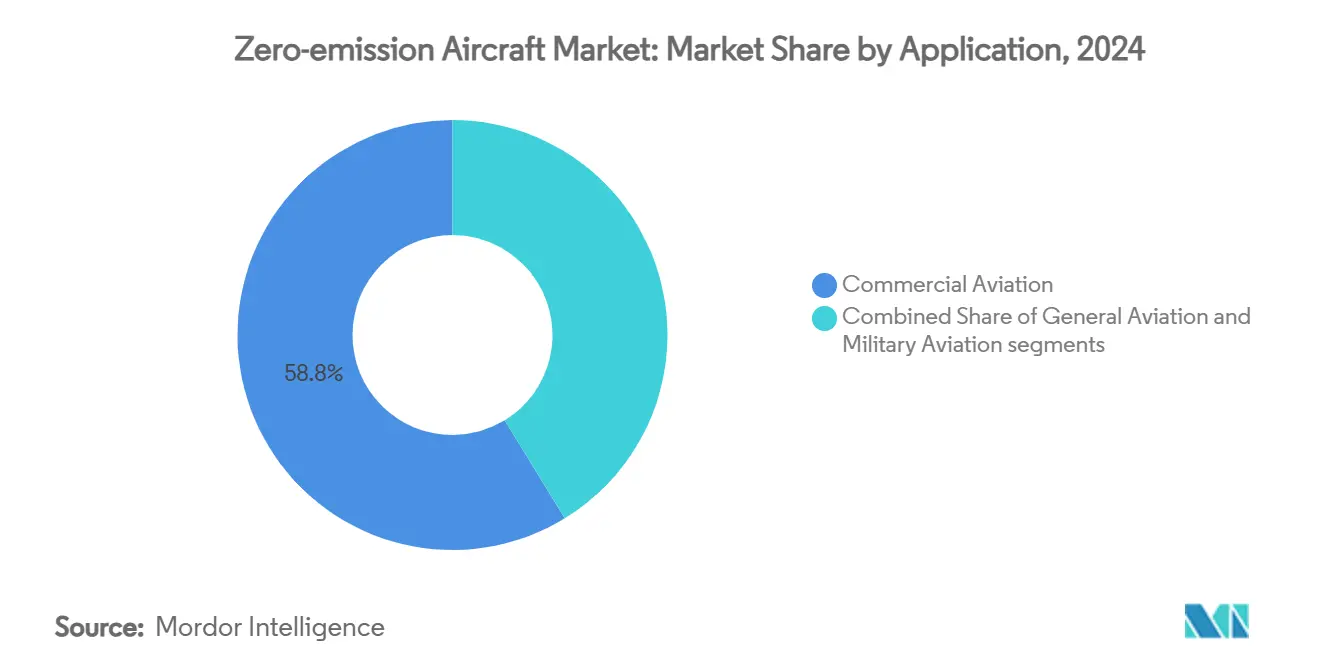
Note: Segment shares of all individual segments available upon report purchase
By Propulsion Technology: Hydrogen Set to Overtake Hybrid Electric Leadership
Hybrid electric systems delivered 46.21% of 2024 revenues as retrofit programs offered airlines lower entry friction. Yet hydrogen fuel-cell architectures are projected to expand at 9.34% CAGR to 2030, buoyed by superior gravimetric energy density and scalable refueling infrastructure initiatives. When liquid hydrogen flight tests with KLM validated three-hour endurance windows, stakeholder confidence in medium-range feasibility rose sharply. As cryotank mass declines, hydrogen aircraft are expected to close the payload gap with traditional turbine fleets, positioning them for core network routes where hybrid battery-assisted propulsion cannot economically compete.
Battery-only designs remain crucial for urban and short-regional missions where simplicity and lower infrastructure complexity provide immediate cost advantages. Continuous cell chemistry and thermal management improvements extend viable stage lengths, but industry consensus still sees hydrogen as the primary pathway for single-aisle category displacement. The technology mix, therefore, evolves from hybrid dominance today toward a dual-track future in which hydrogen captures middle-distance traffic and batteries serve dense short-haul corridors.
By Range: Medium-Range Platforms Catch Up to Short-Haul Front-Runners
Short-range aircraft led 2024 deliveries because early battery versions could only support sub-500 km sectors. However, condensed battery densities that hit 500 Wh/kg have unlocked medium-range concepts, propelling that band to a 6.21% CAGR through 2030. The zero-emission aircraft market size for medium missions will accelerate once prototypes enter service later this decade. Operators gain schedule flexibility when refueling or charging frequency decreases, boosting asset utilization.
Long-range concepts remain heavily hydrogen-dependent given transcontinental sectors' volumetric and gravimetric demands. Aircraft OEMs actively study blended-wing and distributed-propulsion layouts to maximize storage space without compromising aerodynamics. These configurations are unlikely to enter service before 2030, but incremental milestones support investor visibility and justify ongoing R&D outlays in the zero-emission aircraft industry.
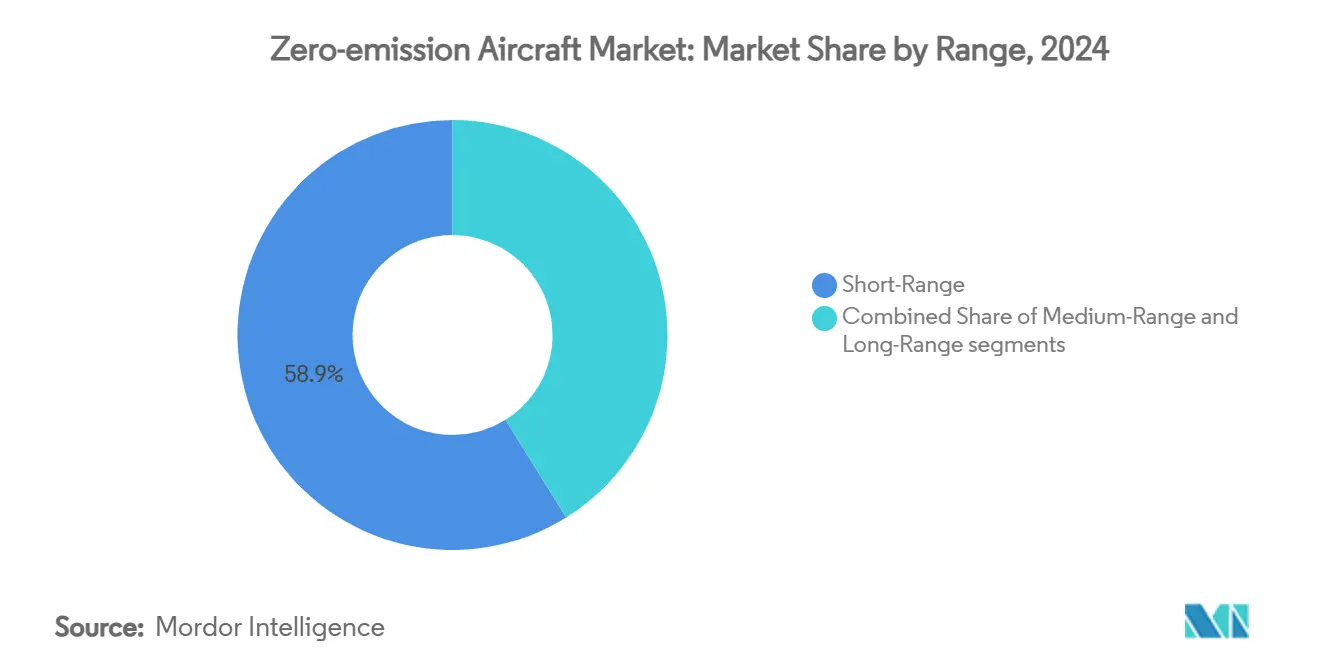
Note: Segment shares of all individual segments available upon report purchase
By Aircraft Type: UAS Growth Outpaces Fixed-Wing Leadership
Fixed-wing programs captured 43.22% of 2024 revenue on the strength of existing supply chains and airline familiarity. Nevertheless, UAS platforms are rising at a 7.95% CAGR by leveraging exemptions from specific crew-safety regulations. Chinese hydrogen-powered drones have already completed prototype flights, providing valuable data on cryogenic handling and redundant control architectures. Cargo and surveillance missions generate early revenue streams that fund technology refinement before scale-up to passenger-carrying models.
Rotorcraft and vertical take-off concepts focus on inner-city mobility, where reduced acoustic signatures ease community acceptance. Regional turboprops form a specialized sub-segment in which hybrid electric conversions offer immediate fuel-burn reductions without complete airframe redesign. Together, these categories diversify risk for investors and ensure the zero-emission aircraft market does not rely on a single platform archetype.
Geography Analysis
North America held 31.54% of 2024 sales, supported by FAA leadership in special-condition rule-making for electric and hydrogen propulsion. Canada’s seaplane retrofits and the United States’ airport-hydrogen task forces showcase operational breadth across passenger and cargo segments. Airline commitments secure installation demand, while manufacturers benefit from established aerospace labor pools and capital markets. Growth to 2030 hinges on timely infrastructure deployment at hub airports.
Asia-Pacific is advancing fastest at 6.82% CAGR, driven by sovereign investment vehicles and vertically integrated supply chains. Japan’s USD 33 billion hydrogen aircraft program aligns aerospace primes with fuel producers, building an end-to-end ecosystem. China’s battery-cell leadership and prototype hydrogen-drone milestones position local OEMs for export competitiveness once global certification reciprocity is achieved. India’s carrier orders for hydrogen-electric powertrains indicate that secondary markets are also coming online quickly.
Europe remains influential through binding emissions targets and research funding instruments such as the Clean Aviation Joint Undertaking. Airbus’s ZEROe demonstrators and Rolls-Royce propulsion investments underscore the region’s advanced-technology credentials. Harmonized charging and refueling standards under ReFuelEU lower deployment friction across member states. Meanwhile, selected Middle East and African nations explore technology transfer partnerships tied to renewable-hydrogen mega-projects, though current volumes remain marginal.
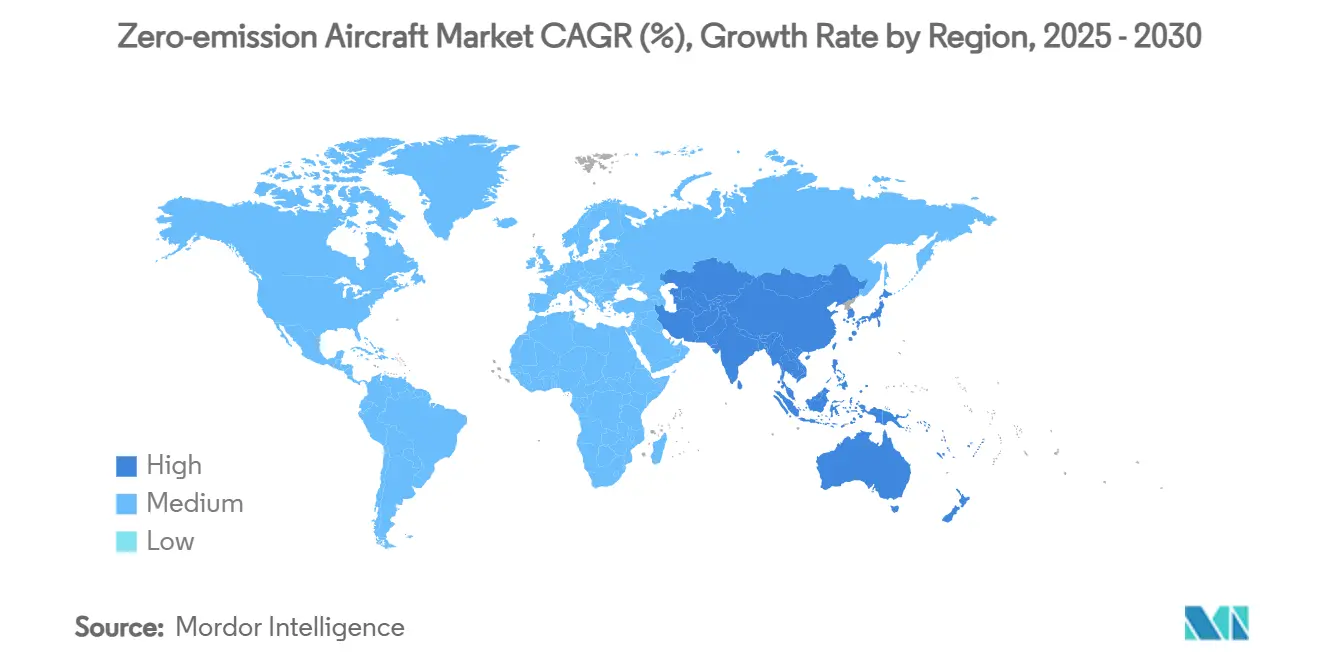
Competitive Landscape
The zero-emission aircraft market is fragmented as deep-tech start-ups compete with legacy OEMs already entrenched in certification processes. ZeroAvia, Inc. leads the hydrogen segment following FAA G-1 concurrence and multiple airline letters of intent, combining proprietary stack technology with vertically integrated fuel infrastructure alliances.[4]ZeroAvia, “FAA G-1 Certification Basis,” zeroavia.com Heart Aerospace AB and BETA Technologies, Inc. are capitalizing on regional lift demand with 30-seat hybrid electric designs under the FAA’s Center for Emerging Concepts and Innovation funding umbrella, accelerating time to market for sub-100-seat categories.
Incumbent manufacturers are hedging through multi-path strategies. Airbus channels over 40% of its R&D budget toward hydrogen airframes and superconducting motors, whereas Boeing pairs SAF production investments with blended-wing demonstrators targeting a 30% fuel-burn cut. Engine majors such as Rolls-Royce and Pratt & Whitney collaborate on thermal-management and fuel-cell balance-of-plant systems to safeguard propulsion market share. Over the next five years, certification readiness, not technological novelty alone, will determine which platforms move from prototype to high-rate production.
Zero-emission Aircraft Industry Leaders
-
The Boeing Company
-
ZeroAvia, Inc.
-
Heart Aerospace AB
-
Airbus SE
-
Rolls-Royce Holdings plc
- *Disclaimer: Major Players sorted in no particular order
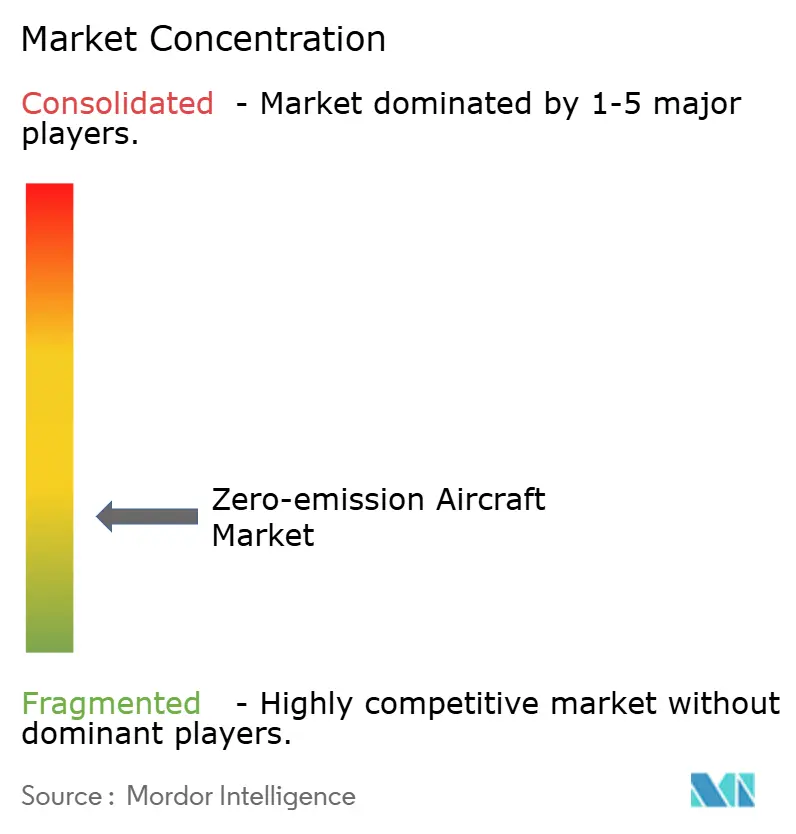
Recent Industry Developments
- June 2025: ZeroAvia signed a Memorandum of Understanding (MoU) with Loganair to explore adopting hydrogen-electric engines for zero-emission flights. The company is pursuing a 600kW hydrogen-electric powertrain certification for 10-20 seat aircraft with the UK's Civil Aviation Authority.
- March 2025: ZeroAvia received a Small Business Innovation Research (SBIR) grant from AFWERX to study the integration of hydrogen propulsion and advanced automation technology in Cessna Caravan aircraft, as part of AFWERX's program to address research priorities related to critical challenges within the Department of the Air Force (DAF).
Global Zero-emission Aircraft Market Report Scope
The aviation sector is investing in green technology. A global effort is underway, with international airlines pouring millions into innovation that green tech pioneers are developing. Zero-emission aircraft is one such concept that has gained popularity in the recent past.
The zero-emission aircraft market is segmented by application and geography. By application, the report has been segmented into commercial and general aviation, and military aviation. The report also covers the market sizes and forecasts in major regions. For each segment, the market size is provided in terms of value (USD).
| Commercial Aviation |
| General Aviation |
| Military Aviation |
| Hydrogen |
| Hybrid Electric |
| Fully Electric |
| Short-Range |
| Medium-Range |
| Long-Range |
| Fixed-Wing |
| Rotorcraft |
| Unmanned Aerial Systems |
| Regional Turboprop/Turbofan |
| North America | United States | |
| Canada | ||
| Mexico | ||
| Europe | United Kingdom | |
| France | ||
| Germany | ||
| Rest of Europe | ||
| Asia-Pacific | China | |
| India | ||
| Japan | ||
| South Korea | ||
| Rest of Asia-Pacific | ||
| South America | Brazil | |
| Rest of South America | ||
| Middle East and Africa | Middle East | Saudi Arabia |
| United Arab Emirates | ||
| Rest of Middle East | ||
| Africa | South Africa | |
| Rest of Africa | ||
| By Application | Commercial Aviation | ||
| General Aviation | |||
| Military Aviation | |||
| By Propulsion Technology | Hydrogen | ||
| Hybrid Electric | |||
| Fully Electric | |||
| By Range | Short-Range | ||
| Medium-Range | |||
| Long-Range | |||
| By Aircraft Type | Fixed-Wing | ||
| Rotorcraft | |||
| Unmanned Aerial Systems | |||
| Regional Turboprop/Turbofan | |||
| By Geography | North America | United States | |
| Canada | |||
| Mexico | |||
| Europe | United Kingdom | ||
| France | |||
| Germany | |||
| Rest of Europe | |||
| Asia-Pacific | China | ||
| India | |||
| Japan | |||
| South Korea | |||
| Rest of Asia-Pacific | |||
| South America | Brazil | ||
| Rest of South America | |||
| Middle East and Africa | Middle East | Saudi Arabia | |
| United Arab Emirates | |||
| Rest of Middle East | |||
| Africa | South Africa | ||
| Rest of Africa | |||
Key Questions Answered in the Report
How large is the zero-emission aircraft market today?
The zero-emission aircraft market size stands at USD 7.86 billion in 2025 and is on course to reach USD 10.25 billion by 2030, reflecting a 5.45% CAGR.
Which propulsion technology is growing fastest in zero-emission aviation?
Hydrogen fuel-cell propulsion is the fastest-growing technology segment, registering a 9.34% CAGR through 2030 amid rising cryogenic-storage breakthroughs.
What region is expanding most quickly in zero-emission aircraft adoption?
Asia-Pacific leads growth with a 6.82% CAGR due to significant government funding and integrated manufacturing supply chains.
Which segment currently dominates by application?
Commercial aviation holds the largest revenue share at 58.75% due to predictable fleet-replacement cycles and airline commitments.
What are the primary barriers to widespread zero-emission aircraft deployment?
Lengthy certification timelines and limited availability of aerospace-grade liquid hydrogen tanks are the top restraints, each shaving close to 1 percentage point from forecast CAGR.
Who are the key players to watch?
ZeroAvia, Inc., Airbus SE, The Boeing Company, Heart Aerospace AB, and Rolls-Royce Holdings plc are among the companies making significant technology and certification strides.
Page last updated on:
